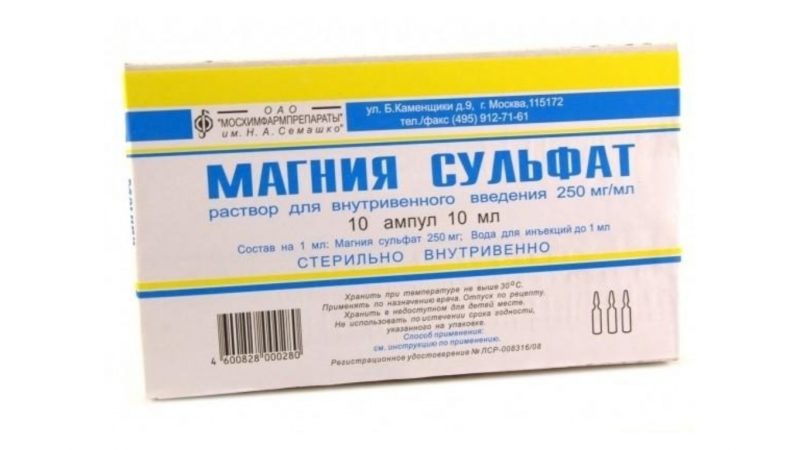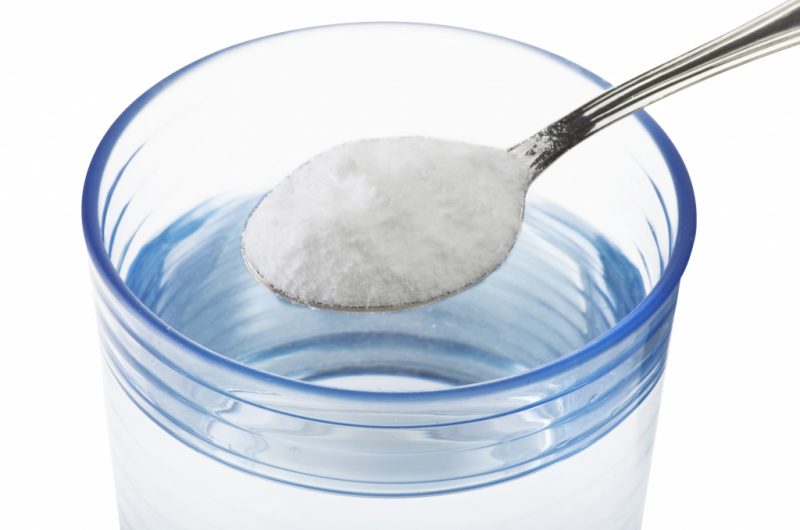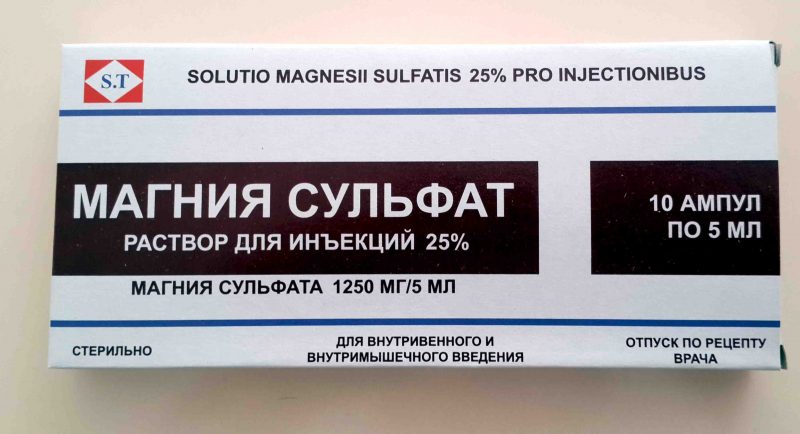Some drugs are distinguished by the universality of exposure, which invariably affects the number of indications for their use. For instance, magnesium sulfate, better known as magnesia, appears immediately in twenty-two positions according to the nosological classification of ICD-10.
What healing opportunities are contained in the medicine, and how to correctly use them, you will learn from our article.
Material Content:
- 1 Magnesium sulfate: release forms, composition
- 2 Pharmacological features
- 3 Instructions for use Magnesium Sulfate
- 4 Use of Magnesium Sulfate for Bowel Cleansing
- 5 How to use magnesia for weight loss?
- 6 Magnesium sulfate during pregnancy and lactation
- 7 Drug interaction
- 8 Possible side effects. Contraindications
Magnesium sulfate: release forms, composition
Magnesium sulfate is a substance for the treatment of pathologies that occur against the background of nervous and muscle tension or excitability.
The structural formula of the agent is MgSO4 - magnesium salt of sulfuric acid.

This substance belongs to the following types of pharmacological groups:
- micro- and macrocells - mineral, biologically active elements necessary for a full human life;
- vasodilators - agents with a vasodilating effect;
- sedatives - medicines that provide a calming effect on the central nervous system.
The medicine is available in the form of sachets with powder (20, 25 g) from colorless prismatic crystals, on the basis of which a suspension is prepared for oral administration, and ampoules with a ready-made solution for injection (5 ml).
Pharmacological features
The pharmacological potential of the drug is due to the properties of the active component of magnesium in its basis.

The therapeutic effect of magnesium sulfate is expressed in therapeutic results:
- relieves muscle spasms and smooth muscles;
- regulates metabolism;
- eliminates intraventricular arrhythmias;
- stops cramps or prevents their appearance;
- lowers blood pressure;
- expands arteries;
- weakens the effects of poisons;
- reduces the fluid content in tissues, stimulates diuresis;
- depending on the size of the dose, it has a depressing effect on the nervous system, relieves pain, and has sleeping pills;
- increases the intensity of intestinal motility;
- promotes the withdrawal of bile.
The area of influence and the degree of effectiveness of magnesium sulfate directly depends on the method of application and the selected dosage.
Features of treatment with magnesium sulfate
Since the therapeutic effect of magnesium sulfate is determined by the method of its use, the purpose of injection of the drug differs in indications from the internal intake.

Introduction Magnesium sulfate is intramuscularly prescribed for:
- hypertensive seizures (including complicated forms);
- the potential for premature birth;
- hypomagnesemia, including acute forms, or malnutrition;
- ventricular arrhythmias and tachycardia;
- encephalopathy;
- convulsive conditions due to complicated pregnancy;
- eclampsia;
- asthmatic attacks;
- poisoning;
- epilepsy;
- delayed urine output;
- alcoholism syndrome.
The intake of magnesium salt inside helps with gastrointestinal pathologies.
Besides, oral administration of magnesia is recommended, as a laxative for cleansing the gastrointestinal tract, before duodenal sounding or diagnostic measures inside the intestine.
Instructions for use Magnesium Sulfate
In order for the patient to be able to choose the exact dosage, instructions for using magnesium sulfate are attached to each package of the medicine. It indicates how much drug is needed in the treatment of various pathological conditions.
Magnesium sulfate - crystalline powder
Magnesia crystals quickly dissolve in water, but are insoluble in ethanol, and have the ability to weather when exposed to air.
To prepare a laxative suspension, 10-30 g of powder is taken per 100 ml of warm drinking ode. Recommended late night or morning reception - half an hour before breakfast. Children who have reached the age of 12 are shown 10 g of the substance per 100 ml of water.

As a choleretic agent, the suspension is taken three times a day, one tablespoon.
For intoxication, Magnesium sulfate powder is used to cleanse the stomach cavity.
The permissible daily dose is 40 g of the drug.
Magnesium Sulfate Ampoules
For injection use ready-made magnesium sulfate in ampoules. A single dose for an adult is from five (one ampoule), up to twenty ml of a 25% solution - twice a day for 20 days.

In children, the drug is indicated for convulsive conditions as an intramuscular injection. In the treatment of eclampsia and late toxicosis, alternating intravenous and intramuscular injections every four hours is recommended.
With the introduction of funds, the patient should take a prone position. The injection is performed slowly - the first three ml of the solution is administered within three minutes.
For infusion, the contents of one ampoule are dissolved in 400 ml of a five percent glucose solution.
Use of Magnesium Sulfate for Bowel Cleansing
Due to its ability to attract water, magnesium sulfate is classified as a saline laxative.
The effectiveness of the use of the drug did not go unnoticed by the diagnosticians. For this reason, the drug was widely used as a means to cleanse the intestines before important diagnostic measures.
When using magnesium sulfate to cleanse the intestines in the cells of the digestive tract, water is retained.Under its influence, fecal masses quickly soften and increase in volume, as a result of which, peristalsis is enhanced and the content is excreted.
To cleanse the intestines, magnesia is administered orally. In this case, most of the drug is excreted in the course of defecation, and only a small percentage is processed by the kidneys and leaves the body with urine.
Preparing the body before cleansing with magnesia
Preparations for cleansing the intestine with magnesium sulfate begin one to two weeks before the procedure. Preparation is necessary in order to relieve the intestines from food deposits as much as possible, and thus increase the effectiveness of cleaning with the drug.

In preparation for cleansing the intestine, it is recommended to change the usual diet, excluding dishes from it that are poorly digestible. That is, all:
- fatty, fried, smoked, pickled and canned;
- sweet and flour;
- alcohol or carbonated.
Meat and seafood should be limited. Instead of heavy food, it is recommended to introduce as many vegetables, fruits and cereals as possible into the diet. An additional dietary effect will provide a properly organized drinking regime - 1.5-2 liters of fluid per day, including water, fruit drinks and herbal decoctions.
Features of magnesia cleaning
There are two methods for freeing the intestines from food deposits with magnesium sulfate - fast (two days) and moderate (five to seven days). The procedure is not addictive and provides an effective result.
Quick way
A quick cleansing procedure is carried out once, in case of urgent need. The first day is reserved directly for the event, the second is necessary to provide the body with rest and recovery.
For cleaning, one sachet of magnesium sulfate weighing 25 g is dissolved in a glass of water. Drink the solution in the early morning. The optimal procedure time is seven in the morning, when the intestines are in a state of maximum activity.

The taste of the solution differs in bitterness, therefore, after taking the remedy, it is allowed to eat a slice of lemon or orange.
It is further recommended that every twenty minutes drink a glass of clean water with a total volume of 2.5 liters.
The effect of the drug begins in one and a half to two hours and can last more than three hours. Desires for bowel movements may be accompanied by flatulence and abdominal pain. The first stool usually has a greenish tint.
Eating is possible only after the urge to defecate has stopped - that is, no earlier than three hours later.
After the completion of the cleansing procedures, it is recommended to take measures to restore the intestinal microflora.
Moderate way
A longer way to cleanse the intestines involves the daily use of a solution of magnesium sulfate for a week. Recommended morning intake of a solution from one sachet, on an empty stomach. Next, you should exclude meals before lunch.

During the cleansing period, avoid physical activity and stress. In addition, it is necessary to continue to adhere to the diet recommended for preparation for the procedure.
How to use magnesia for weight loss?
The use of magnesium sulfate is one of the effective methods of weight loss. To achieve the result, magnesia for weight loss is added to the bath.

The optimal composition for bathing:
- 500 g of magnesium sulfate;
- a kilogram of sea salt;
- pack of baking soda.
All of these components are dissolved in water for bathing. Recommended water temperature is 38 ° C. The time of the procedure is 15-20 minutes. Frequency - once a week.
It is important that when taking baths with Magnesium sulfate, the heart area is above the water level.
Magnesium sulfate during pregnancy and lactation
The use of magnesium sulfate during pregnancy and lactation is possible only in special cases. Among the main indications of treatment for pregnant women are eclampsia and late toxicosis. The drug is administered intravenously, by the drip method.
In the prenatal period, the use of the drug is strictly contraindicated - Magnesium sulfate helps to dilate blood vessels in the uterus and increase blood flow, which can cause bleeding during childbirth.
There is currently no information on the possible adverse effect of the product on the embryo. Nevertheless, treatment with magnesia for pregnant and lactating women is justified only in cases where there is a serious threat to the health of a woman.
Nursing mothers should stop breastfeeding during treatment with magnesium sulfate.
Drug interaction
The use of magnesia with other medicines is fraught with serious health consequences. Therefore, when taking the medicine, its pharmacological features should be taken into account.
Magnesium sulfate has the property of enhancing the activity of drugs that suppress the activity of the nervous system.
Simultaneous administration with calcium salts leads to the neutralization of the therapeutic effect of the drug.

With oral administration, simultaneous treatment with calcium-containing drugs is unacceptable.
Taking glycosides with magnesium sulfate leads to hypomagnesemia. The additional use of calcium can cause a violation of cardiac conduction and provoke heart block.
The use of magnesia together with tetracyclines causes the formation of complexes that are not amenable to absorption.
With the contact of magnesium sulfate with muscle relaxants, the development of neuromuscular blockade and restriction of muscle functionality are possible.
Therapy with magnesium salts when drinking alcohol promotes the excretion of magnesium in the kidneys, which leads to urolithiasis.
Possible side effects. Contraindications
The effects of magnesium sulfate on the body are characterized by intensity, which, in the presence of contraindications, can cause undesirable consequences.

Therefore, drug treatment is not recommended for patients with:
- hypotension;
- inflammatory processes in the digestive tract;
- gallstone disease;
- hypotension;
- atrioventricular heart block;
- impaired renal system.
One of the most pronounced manifestations of adverse reactions after treatment with magnesium sulfate is hypermagnesemia - an excess of the amount of magnesium in the body that develops against the background of renal failure.
Due to an excess of magnesium, nausea and vomiting occur, a sharp decrease in pressure and a headache. Bradycardia and decreased speech function are also possible.
If you have any ailments after applying magnesia, it is recommended to immediately seek medical help.
Like any other medicine, Magnesium Sulfate is not a panacea, but a means that under certain circumstances can not only improve well-being, but also save someone's life.












